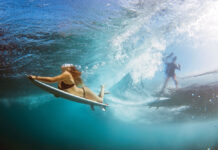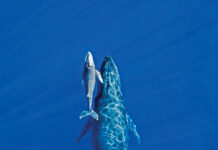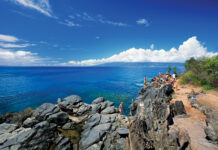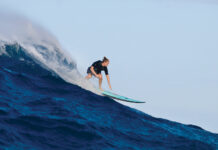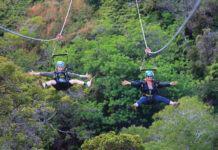Story by Lehia Apana
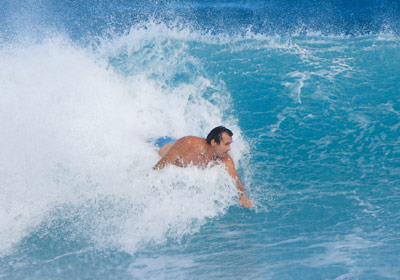
Ask almost any bodysurfer and you’ll hear it: bodysurfing is not cool. There are no sponsors vying for attention, no magazine covers, and just a handful of official contests.
Indeed, the burning spotlight of surf media rarely shines on the sport. For many bodysurfers, though, that’s just fine.
“It’s underground and nearly invisible to the public,” says Kuau resident Jerry Wilson. “There’s little or no commercial potential, but it’s aesthetically and kinetically the coolest thing you’ll ever experience.”
Jerry’s introduction to bodysurfing was tumbling through Nanakuli Beach Park shore break on Oahu, on weekends spent with his family. He admits that back then, it was more about getting slammed by the swell than riding a proper wave, a technique he refers to as “bodywhomping.”
“We’d be out there all day just playing around and getting pounded by the waves — the stuff that every kid in Hawaii grows up doing,” the fifty-four-year-old explains.
“But that’s not true bodysurfing,” he adds with a grin.
True bodysurfing involves gliding across the wave face, using one’s body as if it were a surfboard. (“Across” is a relative position. In traditional surfing, you’re riding a board atop the water’s surface. In bodysurfing, you’re submerged.)
Many bodysurfers wear fins to gain speed when catching a wave, and some use hand planes that range from wooden planks to McDonald’s lunch trays, but that’s about it for equipment. The skill is in the technique.
Bodysurfers propel themselves — by pushing off the ocean floor or swimming — to match the speed of an oncoming wave, then stretch out like a plank. Extending the arm nearest the wave curl lets the surfer cut diagonally across the wave face.
Some bodysurfers remain closer to shore and catch the inside wave breaks, while others, like Jerry and friend Roger Anderson, swim into deep water where surfers wait for incoming swells.
“There’s an attraction to swimming around in big water. You’re out there swimming under ten-foot walls of violent whitewater,” says Roger, forty-six.
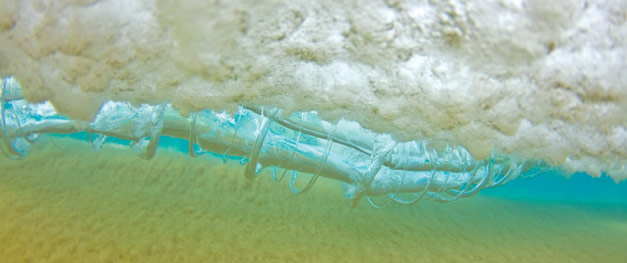
Steep drops and punishing barrels formed in the hollow of a wave can crunch bodies and send even the keenest bodysurfer soaring through the air like a flying fish. And without the respite of a board, bodysurfers are constantly on the move, pushing to stay afloat and jockeying for a spot in the lineup.
“You get the beating of a football player and the vigorous cardio of an Olympic swimmer,” Roger explains.
Then there are finned water hazards — not sharks, but turtles — which have been known to accidently pummel bodysurfers gliding across the wave. Colliding with a turtle can be a true man-versus-nature battle.
“If a surfer hits a turtle, he breaks his [surfboard] fin off. If we hit a turtle, we’re probably going to the ER,” Jerry says, adding that he’s had some close calls.
Jerry and Roger each spent decades in surfboard manufacturing. Jerry has since left the industry to work in hospitality; Roger is the factory manager at Kazuma Surfboards in Haiku. The irony isn’t lost on them that they’ve both devoted years to surfboards, while having such passion for a sport that doesn’t use them.
“We go into the water and all the guys we shaped boards for are looking at us like, ‘What?’” Roger says. “It’s a weird feeling.”
Without a board, it’s also impossible to pull off many tricks or fancy maneuvers. Bodysurfing distills the sport to its most elemental form. Distractions are stripped away, and all that’s left is the surfer and the wave.
“When you’re unencumbered by any equipment, it’s just pure,” says Jerry. “It’s your body and the moving water, and that’s it.”
But he admits that riding sans board has its downside. Jumping in the water without a board assures you’ll be at the bottom of the lineup totem pole. If the surf break is crowded and waves are at a premium, bodysurfers must vie for every ride.
“There’s not enough waves to go around,” explains Jerry. “We’re on a different level in the lineup — the other surfers either don’t see you or don’t respect you, so it can be pretty rough.”
With bodysurfing largely “underground,” some of the best in the sport remain anonymous. One exception is Mark Cunningham, a retired lifeguard on Oahu’s North Shore and the silver-haired star of Keith Malloy’s Come Hell or High Water. This cinematic homage to the sport is the only surf film dedicated entirely to boardless wave riders. In the film, Malloy refers to bodysurfing as a “lost art form.”
As with surfing, bodysurfing — he’e umauma in Hawaiian — began thousands of years ago among the Polynesians, although little is known about its exact origins.
The earliest account of the sport came in 1899, when Australian Fred Williams was taught to bodysurf by Tommy Tanna, a Polynesian working as a gardener for a wealthy Australian family. Williams passed the skill on to others and bodysurfing spread along the coast.
Bodysurfing gained momentum in America in the 1920s, thanks to Olympic swimmer Wally O’Conner of Los Angeles, who would draw a crowd at local beaches by waiting in the shallows, then pushing off the sand to ride the wave’s whitewater into shore.
Among the most well-known bodysurfers is Hawaii’s own President Barack Obama, who was famously pictured charging his way through the shore break at Sandy Beach on Oahu.
“He actually had good form — I was surprised,” Roger says of Obama’s bodysurfing skills. “I could tell he knew what he was doing.”
That’s the beauty of bodysurfing — everyone from the local kid at the beach to the President of the United States can do it.
The common denominator is a love for the ocean, says Lahaina resident Beverly Johnsen, sixty-seven. “I don’t think you can teach bodysurfing. You just have to have something inside you that’s one with the ocean.”
A Kailua, Oahu, native, Beverly grew up playing in the shore break there. Though she later transitioned into board surfing, she credits bodysurfing with helping her to meet her husband, legendary surfboard shaper Bob “Ole” Olson, who was inducted into the International Surfboard Builders Hall of Fame in 2009. Beverly chuckles at the obvious incongruity, but says bodysurfing is the reason they’ve been happily married for thirty-four years. The couple met while bodysurfing at Slaughterhouse, a surf break just off Mokuleia Beach in West Maui.
“I always knew that if I met somebody bodysurfing, it would be a person I could relate to on a deep level — a guy who shared that spiritual connection with the ocean.”
Though she’s participated in just about every water sport, Beverly says there’s nothing that matches the “stoke” that bodysurfing provides. It’s a throwback to the uncensored glee of small-kid days, the purest form of communion with the ocean and a therapeutic outlet.
“You can never have a bad time bodysurfing,” she smiles.
In fact, it’s been said that the best surfer in the water is the one having the most fun. Bodysurfers, in that case, might just be the greatest surfers out there.

